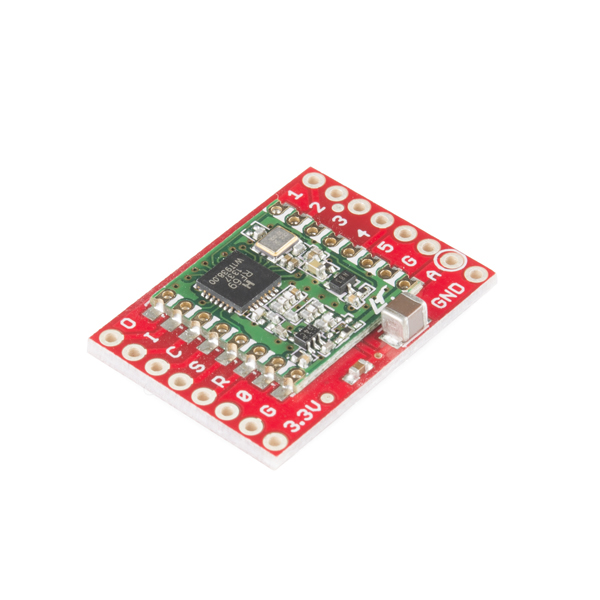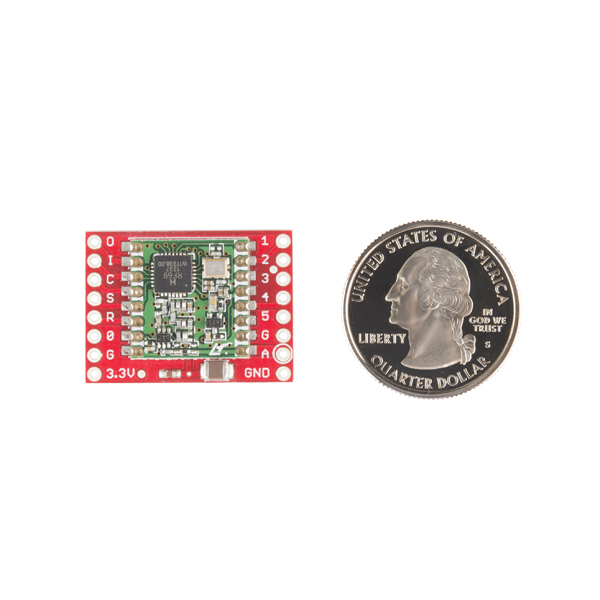SparkFun RFM69 Breakout (434MHz)
This is the SparkFun RFM69 Breakout, a small piece of tech that breaks out all the pins available on the RFM69HCW module as well as making the transceiver easy to use. The RFM69HCW is an inexpensive and versatile radio module that operates in the unlicensed ISM (Industry, Science and Medicine) radio band. It's perfect for building inexpensive short-range wireless networks of sensors and actuators for home automation, citizen science and more.
This RFM69HCW operates on the 434MHz frequency and is capable of transmitting at up to 100mW and up to 300kbps, but you can change both of those values to fit your application. For example, you can maximize range by increasing the transmit power and reducing the data rate, or you can reduce both for short-range sensor networks that sip battery power. At full power and with simple wire antennas, we can get messages from one side of a large office building to the other through numerous internal walls. In open air you can reach 500 meters or more. With more complex antennas and modulation schemes, similar parts have successfully transmitted from space to the ground (by very smart amateur radio enthusiasts; your mileage may vary)!
The RFM69HCW uses an SPI (Serial Peripheral Interface) to communicate with a host microcontroller, and several good Arduino libraries are available. It supports up to 256 networks of 255 nodes per network, features AES encryption to keep your data private, and transmits data packets up to 66 bytes long.
SparkFun sells two versions of the RFM69HCW: a 915MHz version and this 434MHz version. Although the ISM band is license-free, the band itself is different in different areas. Very roughly, 915MHz is for use in the Americas, and the 434MHz version is for use in Europe, Asia and Africa. Check your local regulations for other areas.
- Transmit power: -18dBm (0.016mW) to +20dBm (100mW) in 1dBm steps
- Receive sensitivity: down to -120dBm at 1.2kbps
- Modulation types: FSK GFSK MSK GMSK OOK
- Bit rates (FSK): 1.2kbps to 300kbps
- Voltage range: 1.8V to 3.6V
- Current consumption: 0.1uA sleep, 1.25mA standby, 16mA receive, 130mA transmit (max)
- Encryption: AES 128-bit (optional)
- Packet buffer (FIFO): 66 bytes
- 0.8" x 1.1"
SparkFun RFM69 Breakout (434MHz) Product Help and Resources
RFM69HCW Hookup Guide
April 29, 2016
The RFM69HCW is an inexpensive transceiver that you can use to create all kinds of wireless projects. This tutorial will help you get started.
How to Build a Remote Kill Switch
May 31, 2016
Learn how to build a wireless controller to kill power when things go... sentient.
Using the RFM69 Breakout with Arduino Yun and Leonardo
If you need to use this with a Yun, (or Leonardo) it can be done. First, connect your SPI pins to the ICSP header. CS in the library on a Yun is not on pin 10. It's on the RX LED. See this picture for a connection diagram. You might want to edit the library code to move CS to a more convenient location.
Core Skill: Soldering
This skill defines how difficult the soldering is on a particular product. It might be a couple simple solder joints, or require special reflow tools.
Skill Level: Noob - Some basic soldering is required, but it is limited to a just a few pins, basic through-hole soldering, and couple (if any) polarized components. A basic soldering iron is all you should need.
See all skill levels
Core Skill: Programming
If a board needs code or communicates somehow, you're going to need to know how to program or interface with it. The programming skill is all about communication and code.
Skill Level: Rookie - You will need a better fundamental understand of what code is, and how it works. You will be using beginner-level software and development tools like Arduino. You will be dealing directly with code, but numerous examples and libraries are available. Sensors or shields will communicate with serial or TTL.
See all skill levels
Core Skill: Electrical Prototyping
If it requires power, you need to know how much, what all the pins do, and how to hook it up. You may need to reference datasheets, schematics, and know the ins and outs of electronics.
Skill Level: Rookie - You may be required to know a bit more about the component, such as orientation, or how to hook it up, in addition to power requirements. You will need to understand polarized components.
See all skill levels
Comments
Looking for answers to technical questions?
We welcome your comments and suggestions below. However, if you are looking for solutions to technical questions please see our Technical Assistance page.
Customer Reviews
No reviews yet.





Slightly disappointed by how wide this breakout is. It's approx 25mm -- enough that it spans the center of a breadboard and nine of the holes. That means you can't use the breakout on a 10-wide breadboard. I get that I can use the male headers and hook it up that way but it does visually seem like the board could have been made 2mm narrower, maybe just by turning the radio on its side?
Haven't had the time to test the board yet, but the distance between the headers is a bit odd. On a standard breadboard, it becomes hard to connect wires to the module, because it only leaves one row on one side available.
Really need the RFM95 LoRa radio module. For the market where this module is appropriate (low data rate, low power, long distance) the LoRa radios get another 30 dB of link budget. Blows this away from a system perspective.
Actually, RFM22b was used from space.
Will be susceptible to 70cm amateur radio transmissions in the USA 433.00-435.00 Auxiliary/repeater links
We recommend that our US customers order the 915MHz version.
You may want to use a wording stronger than "recommend" when describing when to use these RF products. If someone uses the 434 MHz version of this board in the USA without an appropriate radio licence (434 MHz license free ISM does not exist in USA), technically they are in violation of FCC rules, as I understand.
Because there are valid reasons you might order either frequency, including as you mentioned being licensed to transmit on that band, we're not going to "force" people to buy one or the other based on their location (which may not even be the operational destination of the module). As always we prefer to educate people and let them make informed choices.
That said, we RECOMMEND that our US customers order the 915MHz version. ;)